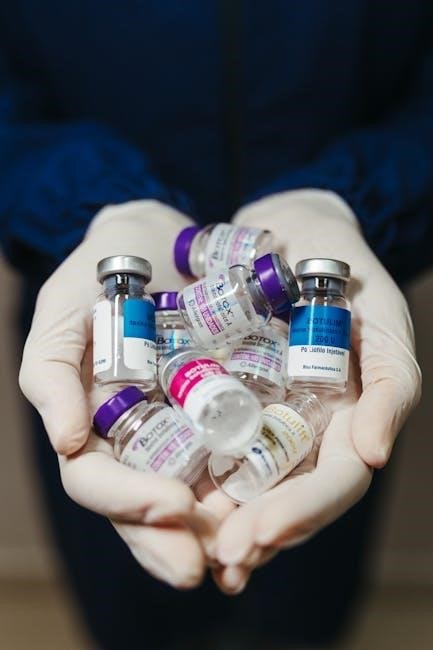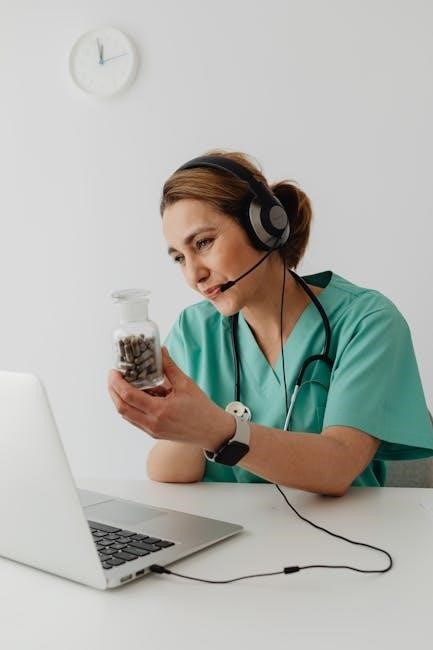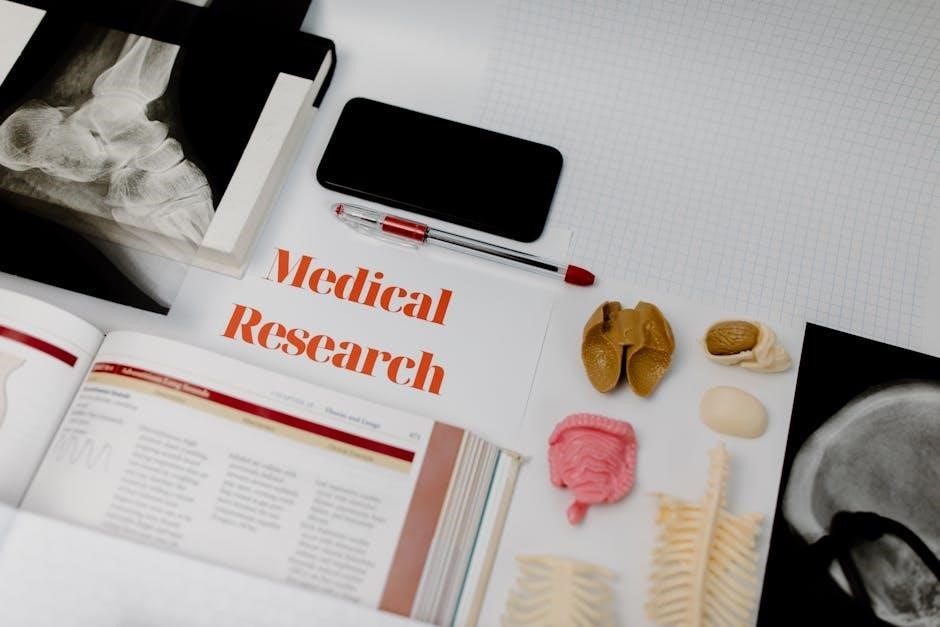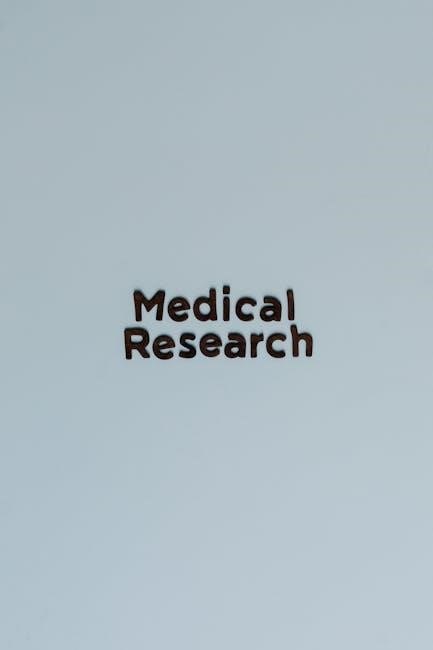Welcome to the nursing pharmacology study guide PDF, a comprehensive resource designed to help nursing students and professionals master pharmacology essentials. This guide covers pharmacology basics, drug classifications, and practical applications, providing a solid foundation for understanding drug therapy principles. Perfect for exam preparation and clinical practice, it offers tips, practice questions, and detailed explanations to enhance your knowledge and skills in nursing pharmacology.
1.1 Importance of Pharmacology in Nursing Practice
Pharmacology is essential for safe and effective medication administration in nursing. Understanding drug mechanisms, interactions, and side effects ensures patient safety and prevents errors. Nurses, as key healthcare providers, must master pharmacology to deliver high-quality care, educate patients, and monitor therapeutic outcomes. This knowledge is critical for preventing adverse reactions and optimizing drug therapy, making it a cornerstone of nursing practice.
1.2 Overview of Pharmacology Basics
Pharmacology basics involve understanding how drugs interact with biological systems. Key concepts include pharmacokinetics (absorption, distribution, metabolism, excretion) and pharmacodynamics (drug effects and mechanisms). Nurses must grasp drug classifications, dosages, and therapeutic uses. This foundation is crucial for administering medications safely and effectively, ensuring optimal patient outcomes. These principles guide evidence-based practice and informed decision-making in clinical settings.

Pharmacokinetics and Pharmacodynamics
Pharmacokinetics involves drug absorption, distribution, metabolism, and excretion, while pharmacodynamics explores drug effects and mechanisms. Understanding these processes is vital for optimizing therapeutic effects and minimizing adverse reactions.
2.1 Pharmacokinetics: Absorption, Distribution, Metabolism, and Excretion
Pharmacokinetics refers to the journey of drugs within the body, encompassing absorption, distribution, metabolism, and excretion. Absorption is how a drug enters the bloodstream, distribution involves transport via blood, metabolism breaks it down, and excretion eliminates it. Nurses must grasp these processes to administer drugs effectively and prevent toxicity, ensuring the right concentration in the body for therapeutic effects.
2.2 Pharmacodynamics: Mechanism of Action and Dose-Response Relationships
Pharmacodynamics examines how drugs interact with the body, focusing on their mechanisms of action and dose-response relationships. It explains how drugs produce therapeutic or adverse effects by binding to receptors or altering cellular processes. Understanding this helps nurses predict drug responses, optimize dosages, and minimize toxicity, ensuring safe and effective patient care. This knowledge is crucial for tailoring drug therapy to individual patient needs.

Drug Classification and Therapy
Drug classification organizes medications by therapeutic use or chemical structure, aiding in targeted therapy. This framework helps nurses select and apply drugs effectively, supported by educational resources like study guides.
3.1 Classification of Drugs by Therapeutic Use
Drugs are classified by therapeutic use to treat specific conditions, such as analgesics for pain or antihypertensives for blood pressure. This system helps nurses understand drug purposes, ensuring appropriate administration and patient safety. Study guides detail common drug classes, their mechanisms, and clinical applications, aiding in effective therapy planning and patient education.
3.2 Classification of Drugs by Chemical Structure
Drugs are also classified by their chemical structure, which determines their pharmacological effects. For example, beta-lactam antibiotics share a common ring structure. This classification aids in understanding drug mechanisms, interactions, and potential adverse effects. Nursing study guides detail these structures, helping nurses predict drug actions and manage therapy effectively, ensuring safe and targeted patient care.
Nursing Process in Pharmacology
The nursing process in pharmacology involves assessment, diagnosis, planning, implementation, and evaluation of drug therapy. It ensures safe, effective, and patient-centered care, guiding nurses in medication management.
4.1 Assessment and Diagnosis in Drug Therapy
Assessment in drug therapy involves evaluating the patient’s health status, medical history, and current medications. Nurses identify potential risks and drug interactions, ensuring safe administration. Diagnosis focuses on determining the appropriate drug regimen and monitoring for therapeutic effects or adverse reactions. This step is crucial for developing individualized care plans and achieving optimal patient outcomes in pharmacological interventions.
4.2 Planning and Implementation of Drug Therapy
Planning involves creating individualized care plans based on assessment findings. Nurses select appropriate drugs, dosages, and routes, considering patient-specific factors. Implementation includes administering medications safely, educating patients on proper use, and monitoring for efficacy and side effects. Accurate documentation and continuous communication with the healthcare team ensure effective therapy and patient safety throughout the process.
4.3 Evaluation of Drug Therapy Outcomes
Evaluation involves assessing the effectiveness of drug therapy and patient responses. Nurses monitor for therapeutic effects, adverse reactions, and toxicity. Patient feedback and lab results are reviewed to determine treatment efficacy. Documentation of outcomes is essential for continuity of care. Adjustments to the treatment plan are made based on evaluation findings, ensuring patient safety and optimal therapeutic results.

Safe Medication Administration
Safe medication administration is a critical nursing responsibility. The nursing pharmacology study guide PDF emphasizes the six rights of medication administration and strategies to prevent errors, ensuring accurate drug delivery and patient safety.
5.1 Six Rights of Medication Administration
5.1 Six Rights of Medicology Administration
The nursing pharmacology study guide PDF highlights the six rights of medication administration: right patient, right drug, right dose, right route, right time, and right documentation. These principles ensure accurate and safe drug delivery, reducing errors and enhancing patient outcomes. Nurses must consistently apply these rights to maintain high standards of care and patient safety in all clinical settings.
5.2 Preventing Medication Errors
Preventing medication errors is critical in ensuring patient safety. The nursing pharmacology study guide PDF emphasizes strategies such as double-checking medication orders, using barcode scanning, and educating patients. Nurses should also be vigilant about high-alert medications and maintain clear communication with the healthcare team. These practices minimize risks and promote accurate drug administration, aligning with safe and effective patient care.
Drug Interactions and Side Effects
Understanding drug interactions and side effects is vital for safe patient care. This section explores types of interactions, potential adverse reactions, and strategies to minimize risks, ensuring optimal therapy outcomes.
6.1 Types of Drug Interactions
Drug interactions are a critical aspect of pharmacology, categorized into drug-drug, drug-food, and drug-disease interactions. These can alter therapeutic effects, leading to adverse outcomes. Understanding these types is essential for safe medication administration and patient care. This section provides insights into identifying and managing interactions to optimize therapy outcomes and ensure patient safety.
6.2 Adverse Drug Reactions and Toxicity
Adverse drug reactions (ADRs) and toxicity are unintended harmful effects of medications. ADRs can be allergic, idiosyncratic, or dose-dependent. Toxicity often occurs at higher doses, affecting specific organs. Nurses must monitor for signs like rashes, respiratory distress, or organ dysfunction. Early identification and reporting are crucial to prevent severe outcomes. Education on risk factors and prevention strategies is key to ensuring patient safety and minimizing harm.
Special Populations and Pharmacology
This section focuses on pharmacology in pediatric, geriatric, pregnant, and lactating populations. It addresses age-related physiological changes, dosage adjustments, and safe medication practices for these vulnerable groups.
7.1 Pediatric and Geriatric Pharmacology
This section covers drug therapy in children and older adults, focusing on age-related physiological changes. It discusses pediatric dosing based on weight and geriatric considerations like renal function. Key topics include developmental stages, pharmacokinetic variations, and monitoring for adverse effects in these populations. Understanding these principles is crucial for safe and effective medication management in vulnerable age groups.
7.2 Pharmacology in Pregnancy and Lactation
This section addresses drug therapy during pregnancy and lactation, focusing on maternal and fetal health. It explores how pregnancy alters drug pharmacokinetics and the risks of teratogenicity. Additionally, it discusses drug safety during breastfeeding, including medication excretion in breast milk and potential infant effects. Understanding these concepts is essential for ensuring safe and effective drug use in these critical life stages.
Cultural, Legal, and Ethical Considerations
This section emphasizes the importance of cultural competence, legal responsibilities, and ethical practices in drug therapy. It addresses respecting patient beliefs, adhering to laws, and upholding patient autonomy while administering medications.
8.1 Cultural Competence in Drug Therapy
Cultural competence in drug therapy is crucial for effective patient care. Nurses must consider patients’ cultural beliefs, values, and practices when administering medications. This includes understanding differences in health perceptions, medication adherence, and communication styles. Tailored education and sensitivity to diverse backgrounds ensure respectful and individualized care, promoting positive health outcomes and enhancing patient trust in the therapeutic relationship.
8.2 Legal and Ethical Issues in Nursing Pharmacology
Legal and ethical issues in nursing pharmacology are critical to ensure safe and responsible drug therapy. Nurses must adhere to professional standards, respecting patient autonomy and confidentiality. Medication errors can lead to legal consequences, emphasizing the need for accurate administration and documentation. Understanding laws governing controlled substances and informed consent is essential. Ethical dilemmas, such as end-of-life care decisions, require nurses to balance patient rights with professional obligations, upholding justice and beneficence in care delivery.
Patient Education and Drug Therapy
Patient education is vital for safe and effective drug therapy. Nurses play a key role in teaching patients about medications, dosage, and potential side effects, ensuring adherence.
9.1 Teaching Patients About Their Medications
Teaching patients about their medications is a critical nursing responsibility. Nurses should explain drug names, purposes, dosages, and potential side effects clearly. Emphasizing proper administration techniques and storage ensures safety. Patients should be encouraged to ask questions and report concerns. Providing written instructions or visual aids can enhance understanding and adherence to treatment plans.
9.2 Promoting Adherence to Drug Regimens
Promoting adherence to drug regimens involves simplifying medication schedules and educating patients on the importance of consistency. Nurses should address potential barriers, such as cost or complexity, and provide tools like pill boxes or reminder apps. Encouraging open communication and offering reassurance can build trust and improve adherence. Regular follow-ups and collaboration with healthcare teams further support patients in maintaining their treatment plans effectively.

Over-the-Counter and Herbal Supplements
Over-the-counter drugs and herbal supplements are widely used for self-care. Nurses must educate patients on their safe use, potential interactions, and side effects to ensure effective health management.
10.1 Common Over-the-Counter Drugs
Common over-the-counter (OTC) drugs include pain relievers (e.g., acetaminophen, ibuprofen), antihistamines, antacids, and cough suppressants. Nurses should understand their indications, dosages, and potential interactions. Patient education is crucial to ensure safe use, especially regarding side effects and contraindications. These medications are widely used for self-care, making it essential for nurses to guide patients on proper administration and monitor for adverse reactions.
10.2 Herbal and Dietary Supplements: Safety and Efficacy
Herbal and dietary supplements, like St. John’s Wort and ginkgo biloba, are widely used but lack strict FDA regulation. Nurses must assess their safety and efficacy, as these supplements can interact with prescribed medications. Patient education is crucial to ensure safe use, emphasizing the importance of consulting healthcare providers before consumption. Understanding potential risks and benefits helps nurses guide patients effectively in integrating these supplements into their care plans.

Advanced Pharmacology Topics
This section explores cutting-edge areas like gene therapy, pharmacogenomics, and biologic therapies, offering insights into personalized medicine and targeted drug development for enhanced patient care.
11.1 Gene Therapy and Pharmacogenomics
Gene therapy involves modifying genes to treat or prevent diseases, while pharmacogenomics tailors drug therapy based on genetic makeup. These advanced fields enable personalized medicine, improving efficacy and reducing adverse effects; Nurses play a key role in educating patients and monitoring outcomes. Understanding these concepts is crucial for modern nursing practice, as they pave the way for targeted and precise drug therapies.
11.2 Biologic and Targeted Therapies
Biologic therapies use living organisms or their derivatives to treat diseases, while targeted therapies focus on specific molecular pathways. These therapies offer precise treatment options, reducing harm to healthy cells. Nurses must understand their administration, potential side effects, and patient monitoring requirements. These therapies are transforming healthcare, emphasizing the need for nurses to stay updated on their mechanisms and clinical applications.

Pharmacology in Specific Clinical Settings
Pharmacology in specific clinical settings involves tailoring drug therapies to unique patient populations and conditions. Nurses must apply pharmacology principles to ensure safe and effective drug administration in various care environments.
12.1 Pharmacology in Critical Care
Critical care pharmacology focuses on managing life-threatening conditions with precise drug therapies. Nurses must understand pharmacokinetics and pharmacodynamics in critically ill patients, including renal and hepatic impairments. Common drugs include vasopressors, sedatives, and analgesics. Titration of medications is crucial to maintain hemodynamic stability and prevent adverse effects. The nursing pharmacology study guide PDF provides detailed insights into these high-acuity scenarios, ensuring optimal patient outcomes.
12.2 Pharmacology in Pain Management
Pain management pharmacology involves using medications to alleviate acute and chronic pain. Key drug classes include opioids, NSAIDs, and adjuvant analgesics. Nurses must assess pain intensity and tailor therapies to individual needs, ensuring safe administration and minimizing side effects. The nursing pharmacology study guide PDF provides insights into pain pathways, drug mechanisms, and non-pharmacological strategies, optimizing comfort and improving patient outcomes effectively.

Pharmacology Resources for Nurses
Discover essential pharmacology resources for nurses, including comprehensive study guide PDFs, online tools, and manuals. These materials provide detailed drug information, practical applications, and exam preparation tips, ensuring clinical competence and confidence in nursing practice.
13.1 Pharmacology Study Guides and Manuals
Pharmacology study guides and manuals are invaluable tools for nursing students and professionals. These resources provide detailed drug classifications, mechanisms of action, and nursing considerations. Available in PDF format, they often include practice questions, NCLEX prep tips, and clinical application scenarios. Manuals also cover pharmacokinetics, pharmacodynamics, and lifespan considerations, ensuring a comprehensive understanding of drug therapy. These guides are essential for mastering pharmacology concepts and excelling in clinical practice.
13.2 Online Resources and Tools for Pharmacology Learning
Enhance your pharmacology knowledge with online resources like NurseInTheMaking and RDHopes, offering free study guides and practice questions. Platforms such as Open RN provide interactive modules, while Quizlet features flashcards for drug classification. Video tutorials and webinars are also available, making learning pharmacology engaging and accessible. These tools support NCLEX prep, clinical practice, and continuous professional development for nursing students and professionals.

Exam Preparation and Practice Questions
Prepare for NCLEX, ATI, and HESI exams with tailored practice questions and detailed explanations. Boost your confidence with study guides and practical applications focused on pharmacology essentials.
14.1 NCLEX Pharmacology Questions and Tips
Master NCLEX pharmacology with targeted practice questions and expert tips. Focus on understanding drug classifications, side effects, and nursing implications. Utilize free study guides and resources like the NCLEX Snack for tailored prep. Prioritize high-yield medications and review common drug interactions. NurseInTheMaking offers comprehensive tools to enhance your pharmacology knowledge and improve test-taking strategies, ensuring confidence on exam day.
14.2 ATI and HESI Pharmacology Practice Questions
Enhance your exam readiness with ATI and HESI pharmacology practice questions. These questions focus on prioritization, patient safety, and drug therapy outcomes. Concentrate on high-yield medications and common drug interactions. Utilize study guides and online tools to master these questions. NurseInTheMaking offers tailored practice tests and detailed explanations to help you excel in pharmacology and achieve success on ATI and HESI exams.

Lifespan Considerations in Pharmacology
Understanding pharmacology across the lifespan is crucial. Factors like metabolism, body composition, and organ function vary with age, affecting drug responses. Tailored dosages and monitoring ensure safe, effective therapy for pediatric and geriatric patients, optimizing outcomes in nursing care.
15.1 Drug Therapy in Children
Drug therapy in children requires careful consideration of age-related physiological differences. Pediatric dosages are adjusted based on weight and metabolic rates, with formulations tailored to their needs. Monitoring for adverse effects is crucial, as children’s bodies are still developing. Education for caregivers and proper administration techniques ensure safety and efficacy, making pediatric pharmacology a specialized area in nursing practice.
15.2 Drug Therapy in Older Adults
Drug therapy in older adults requires careful consideration of age-related physiological changes, such as reduced metabolism and increased drug sensitivity. Polypharmacy is common, necessitating close monitoring for adverse effects. Nurses must ensure medication regimens are simplified and tailored to individual needs, focusing on quality of life. Comprehensive guides and tools help manage complex drug therapies, ensuring safe and effective care for geriatric patients.
Continuous learning in nursing pharmacology is essential for adapting to emerging trends and innovative treatments. Nurses must stay informed to provide safe, evidence-based care in an evolving field.
16.1 Continuous Learning in Nursing Pharmacology
Continuous learning is vital in nursing pharmacology due to evolving drug therapies and research. Nurses must engage in ongoing education to stay updated on new medications, side effects, and treatment guidelines. Utilizing resources like NCLEX practice questions and pharmacology study guides ensures competency and enhances patient care. Lifelong learning fosters expertise, enabling nurses to adapt to advancements and deliver safe, evidence-based care in diverse clinical settings.
16.2 Emerging Trends in Pharmacology
Emerging trends in pharmacology include advancements in gene therapy, pharmacogenomics, and biologic therapies, offering personalized treatment options. Nurses must stay informed about these innovations to provide evidence-based care. Study guides and online resources help nurses adapt to new drug developments and technologies, ensuring they remain proficient in delivering cutting-edge patient care in an ever-evolving healthcare landscape.